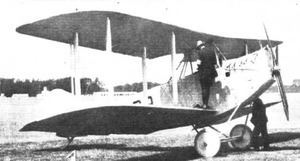Top speed 125 km/h Length 7.85 m | Wingspan 12 m First flight 1925 | |
 | ||
Manufacturer | ||
The LFG V 39 was a simple biplane trainer built in Germany in the mid-1920s. It took part in the Round Germany Flight in the summer of 1925.
Contents
Design and development
The V 39 was a two bay biplane with constant chord wings mounted with slight stagger and a wide gap. The fabric covered wings had box spars and three-ply ribs. There were ailerons on both upper and lower wing, externally rod-connected. The upper wing was centrally supported with cabane struts.
The trainer was designed to be powered by a 75 kW (100 hp) Mercedes D.I or 89 kW (120 hp) D.II engine. It is known that the smaller engine at least was flown. The fuselage was deep bellied, flat sided, constructed from wood and covered with three-ply. There were two open, tandem cockpits, the rear one provided with vision enhancing trailing edge cut-outs in both upper and lower planes. The V 39's undercarriage was standard for the time, with mainwheels on a rigid axle supported by fuselage mounted V-struts and with a tailskid.
The V 39 was designed to combine modest performance with reliability and robustness with easy handling and a low landing speed.
Operational history
The V 39 was one of more than ninety aircraft to take part in the Round Germany Flight held in the summer of 1925.
Specifications
Data from Flight 28 May 1925 p.323
General characteristics
Performance
